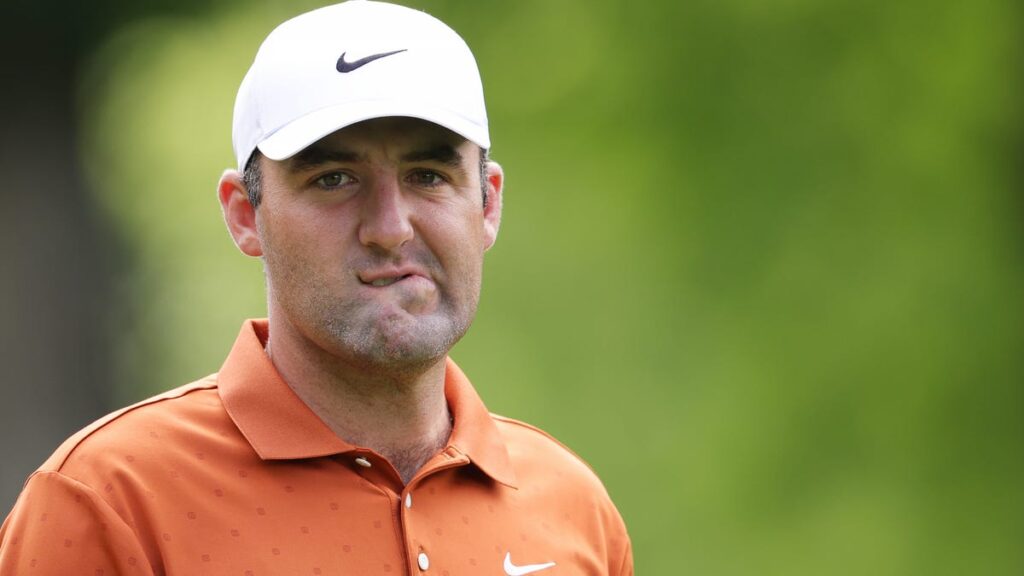Scottie Scheffler shot 69 Thursday at Quail Hollow, but mud balls created frustration and, he says, cost him shots.
Scottie Scheffler is the best iron player on the PGA Tour, with a laser-like precision that’s the envy of just about every tour pro in the game. He can hit it high, low, left or right with brutal consistency — which is why he leads the tour in Strokes Gained: Approach the Green. Compared to the average PGA Tour pro, Scheffler is 1.22 shots better over 18 holes. That adds up to nearly five strokes over a 72-hole tournament.
That’s why it was clear something went wrong when he hit his second shot on No. 16 Thursday at the 2025 PGA Championship. From the middle of the fairway, 221 yards from the hole with an iron in his hand, Scheffler played a shot that he typically hits to within 44 feet of the cup. But this time, the ball flew past the flag, drifted left, bounced off the slope behind the green and into the pond — leading to a double bogey.
Scheffler finished the day with a 2-under 69, but the Texan made it known that the circumstances surrounding that shot, and others at Quail Hollow Club on Thursday, bothered him.
“I hit in the middle of the fairway, then you’ve got mud on your ball, and it’s tough to control where it goes after that,” Scheffler said.
Heavy rain on Monday and Tuesday in Charlotte softened the course. And while the SubAir system did a strong job keeping the greens firm and fast, the fairways remained soft as the first round began Thursday morning.
What are rules for preferred lies (lift, clean, place)?
At week-to-week PGA Tour events, officials often allow players to compete under “preferred lies.” That means if a player’s shot comes to rest in the fairway or on the green, the player can mark the ball’s position, lift it, clean it and place it back down in the same spot. Soft fairways can lead to mud collecting on the ball, randomly penalizing players even after good shots.
Golf purists tend to oppose preferred lies and insist that players play the ball as it lies. In their view, random tough breaks are part of the game — and even out over 72 holes.
To clarify its stance, the PGA of America notified players on Wednesday that they would be “playing the ball down.” In other words, no preferred lies.
When Scheffler was asked about the decision, he didn’t hold back.
“I think when you’re looking at the purest forms of golf, like if you’re going to go play links golf, there’s absolutely no reason on a links golf course you should play the ball up,” he said. “It doesn’t matter how much rain they get. The course could be flooded under water and the ball is still going bounce somehow because of the way the turf is and the ground underneath the turf. In American golf it’s significantly different. When you have overseeded fairways that are not sand capped, there’s going to be a lot of mud on the ball, and that’s just part of it. When you think about the purest test of golf, I don’t personally think that hitting the ball in the middle of the fairway you should get punished for. On a golf course as good of conditioned as this one is, this is probably a situation in which it would be the least likely difference in playing it up because most of the lies you get out here are all really good.”
Scheffler reiterated that he doesn’t make the rules and said he was proud of how well he competed given the tough conditions. But he also pointed out that people who have strong opinions about preferred lies may not fully grasp the situation.
“I understand how a golf purist would be, ‘Oh, play it as it lies.’ But I don’t think they understand what it’s like literally working your entire life to learn how to hit a golf ball and control it and hit shots and control distance, and all of a sudden due to a rules decision that is completely taken away from us by chance.”
What does mud do to a golf ball?
Mud on a golf ball does more than make it look dirty. It creates asymmetrical drag. If there’s mud on the left side of the ball, it tends to veer right in the air — and vice versa — because the clean side of the ball moves faster through the air. The actual result can vary depending on the amount of mud, the club used and how much the ball is spinning.
“Like I said, I don’t make the rules. I deal with what the rules decisions are,” Scheffler said. “I could have let that bother me today when you got a mud ball and it cost me a couple shots. It cost me possibly two shots on one hole, and if I let that bother me, it could cost me five shots the rest of the round. But today I was proud of how I stayed in there, didn’t let it get to me and was able to play some solid golf — on a day in which I was a bit all over the place — and still post a score.”
Read the full article here



